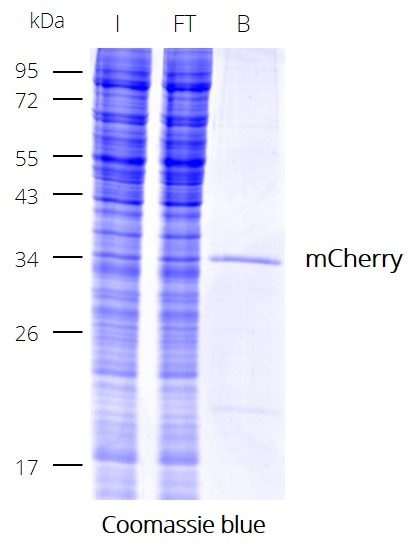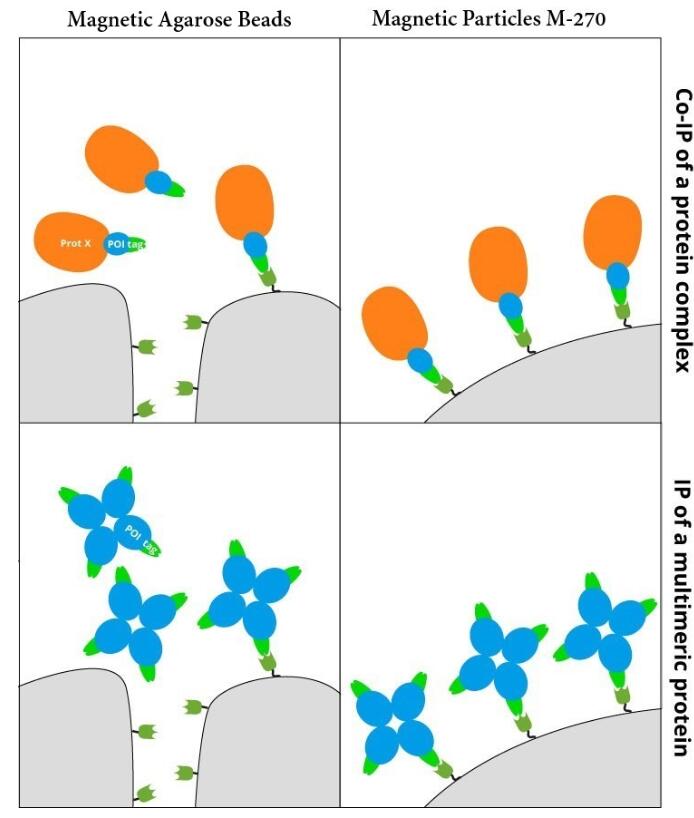Validation Data Gallery
Product Information
RFP-Trap® Magnetic Particles M-270 for immunoprecipitation (IP) of RFP-tagged proteins. RFP-Trap Magnetic Particles M-270 is highly recommended, when very large proteins/complexes are investigated, and magnetic separation is needed for IP. It consists of a RFP VHH/ Nanobody coupled to Magnetic Particles M-270.
| Description | Immunoprecipitation of RFP-fusion proteins and their interacting factors with anti-RFP Nanobody conjugated to magnetic particles. RFP-Trap Magnetic Particles M-270 is recommended when very large proteins/complexes are investigated and magnetic separation is needed for IP.
• IP and Co-IP of RFP-tagged proteins without size limitation • Automation and high throughput applications • Magnetic separation with easy and efficient washing of RFP-Trap Magnetic Particles M-270 • Very high affinity (KD=5 nM) to bind even low abundant proteins • No heavy & light antibody chains, short incubation (5-30 min) • Extraordinary binding, also under harsh conditions |
| Applications | IP, CoIP, ChIP, RIP |
| Specificity/Target | mRFP, mCherry, mRFPruby, mPlum, tagRFP, mKate2, mOrange, PA-mCherry, mScarlet For the complete list, please click here: Fluorescent protein specificity table |
| Binding capacity | 1.25 μg of recombinant mCherry per 25 μL bead slurry |
| Conjugate | Magnetic Particles M-270, size: 2.8 µm high throughput-compatible |
| Elution buffer | SDS sample buffer 0.2 M glycine pH 2.5 |
| Wash buffer compatibility | 0.5 M NaCl, 10 mM DTT, 2 % Nonidet P40 Substitute, 2 % Triton X-100 |
| Type | Nanobody |
| Class | Recombinant |
| Host | Alpaca |
| Affinity (KD) | Dissociation constant KD of 5 nM |
| Compatibility with mass spectrometry | The RFP-Trap® is optimized for on-bead digestion. For the application note, please click here: On-bead digest protocol for mass spectrometry |
| RRID | AB_2861253 |
| Storage Buffer | PBS with 0.09% sodium azide |
| Storage Condition | Shipped at ambient temperature. Upon receipt store at 4°C. Stable for one year. Do not freeze! |
| Size | 25ul/reactions (eg:20rxns=500ul slurry) |
Documentation
| SDS |
|---|
| rtd_SDS_RFP-Trap® Magnetic Particles M-270 (EN) |
| Datasheet |
|---|
| RFP-Trap® Magnetic Particles M-270 Datasheet |
| RFP-Trap Specificity |
|---|
| Fluorescent protein specificity table |
| Trouble shooting |
|---|
| Troubleshooting guide immunoprecipitation (IP) |
Publications
| Application | Title |
|---|---|
Plant Cell Diversification of heat shock transcription factors expanded thermal stress responses during early plant evolution. | |
Cell Rep RNA-binding protein FXR1 drives cMYC translation by recruiting eIF4F complex to the translation start site. | |
New Phytol Increasing amyloplast size in wheat endosperm through mutation of PARC6 affects starch granule morphology | |
Mol Biol Cell FARL-11 (STRIP1/2) is required for sarcomere and sarcoplasmic reticulum organization in C. elegans | |
Nat Commun PARP2 promotes Break Induced Replication-mediated telomere fragility in response to replication stress | |
Mol Cell Alphavirus infection triggers selective cytoplasmic translocation of nuclear RBPs with moonlighting antiviral roles |






